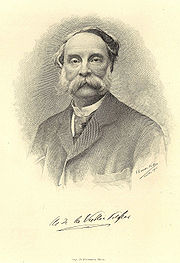
Charles-Louis-Joseph-Xavier de la Vallée-Poussin
Encyclopedia

Namur (city)
Namur is a city and municipality in Wallonia, in southern Belgium. It is both the capital of the province of Namur and of Wallonia....
–1903, Brussels
Brussels
Brussels , officially the Brussels Region or Brussels-Capital Region , is the capital of Belgium and the de facto capital of the European Union...
) was a Belgian geologist
Geologist
A geologist is a scientist who studies the solid and liquid matter that constitutes the Earth as well as the processes and history that has shaped it. Geologists usually engage in studying geology. Geologists, studying more of an applied science than a theoretical one, must approach Geology using...
and mineralogist
Mineralogy
Mineralogy is the study of chemistry, crystal structure, and physical properties of minerals. Specific studies within mineralogy include the processes of mineral origin and formation, classification of minerals, their geographical distribution, as well as their utilization.-History:Early writing...
. His son was the mathematician Charles Jean de la Vallée-Poussin
Charles Jean de la Vallée-Poussin
Charles-Jean Étienne Gustave Nicolas de la Vallée Poussin was a Belgian mathematician. He is most well known for proving the Prime number theorem.The king of Belgium ennobled him with the title of baron.-Biography:...
.
Academic career
Professor of geologyGeology
Geology is the science comprising the study of solid Earth, the rocks of which it is composed, and the processes by which it evolves. Geology gives insight into the history of the Earth, as it provides the primary evidence for plate tectonics, the evolutionary history of life, and past climates...
and mineralogy
Mineralogy
Mineralogy is the study of chemistry, crystal structure, and physical properties of minerals. Specific studies within mineralogy include the processes of mineral origin and formation, classification of minerals, their geographical distribution, as well as their utilization.-History:Early writing...
at the Catholic University of Leuven
Catholic University of Leuven
The Catholic University of Leuven, or of Louvain, was the largest, oldest and most prominent university in Belgium. The university was founded in 1425 as the University of Leuven by John IV, Duke of Brabant and approved by a Papal bull by Pope Martin V.During France's occupation of Belgium in the...
(1863), and a doctor honoris causa of the same university (1876), he was vice president of the directing council of the geological map of Belgium (1903).
He studied humanities at the Collège Notre-Dame-de-la-Paix, Namur, he studied mathematics in Paris, and for ten years devoted himself to literature and philosophy. He attracted attention by his literary and scientific criticisms in various reviews. Appointed professor in 1863 on the recommendation of Omalius d'Halloy
Jean Baptiste Julien d'Omalius d'Halloy
Jean Baptiste Julien d'Omalius d'Halloy was a Belgian geologist. He also wrote on races.- Early life and education :He was born at Liège, Belgium on February 16, 1783. He was the only son of an ancient and noble family, and his education was carefully directed...
, he instigated the teaching of geology and mineralogy at the University of Louvain.
De la Vallée wrote publications on the microscopic study of the crystalline rocks of the Belgian and French Ardennes
Ardennes
The Ardennes is a region of extensive forests, rolling hills and ridges formed within the Givetian Ardennes mountain range, primarily in Belgium and Luxembourg, but stretching into France , and geologically into the Eifel...
, several in collaboration with A.F. Renard
Alphonse Francois Renard
Alphonse Francois Renard , Belgian geologist and petrographer, was born at Ronse, in East Flanders, on 27 September 1842...
. Of these the first (1876) was crowned by the Royal Academy of Belgium. He also wrote numerous notes on the Carboniferous
Carboniferous
The Carboniferous is a geologic period and system that extends from the end of the Devonian Period, about 359.2 ± 2.5 Mya , to the beginning of the Permian Period, about 299.0 ± 0.8 Mya . The name is derived from the Latin word for coal, carbo. Carboniferous means "coal-bearing"...
limestone
Limestone
Limestone is a sedimentary rock composed largely of the minerals calcite and aragonite, which are different crystal forms of calcium carbonate . Many limestones are composed from skeletal fragments of marine organisms such as coral or foraminifera....
s of the Ardennes and fixed the true stratigraphical
Stratigraphy
Stratigraphy, a branch of geology, studies rock layers and layering . It is primarily used in the study of sedimentary and layered volcanic rocks....
relations of its beds and destroy Dupont's theory of lacunæ. He studied the formation of the Valley of the Meuse
Meuse River
The Maas or Meuse is a major European river, rising in France and flowing through Belgium and the Netherlands before draining into the North Sea...
; and wrote popularizing articles, which rank him with the first promoters of physical geography
Physical geography
Physical geography is one of the two major subfields of geography. Physical geography is that branch of natural science which deals with the study of processes and patterns in the natural environment like the atmosphere, biosphere and geosphere, as opposed to the cultural or built environment, the...
. Finally he helped with the preparation of the official geologic map
Geologic map
A geologic map or geological map is a special-purpose map made to show geological features. Rock units or geologic strata are shown by color or symbols to indicate where they are exposed at the surface...
of Belgium.
See also
La Vallée-PoussinLa Vallée-Poussin
The family Delavallée Poussin, also denominated as de la Vallée Poussin or de la Vallée, is a family of the French bourgeoisie coming from Normandy in France....

